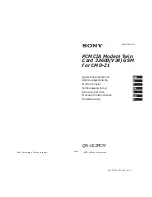
CHAPTER 1: Overview
3
1. Overview
AT commands are used to control your modem’s operation. Each command must be preceded by the
characters A and T to get the modem’s attention.
AT commands can be issued only when the modem is in command mode or online command mode. The
modem is in command mode whenever it is not connected to another modem. The modem is in data mode
whenever it is connected to another modem and ready to exchange data. Online command mode is a
temporary state in which you can issue commands to the modem while you’re connected to another modem.
When you need to send commands to the modem at the other end of the connection, put the modem into
online command mode from data mode. To do this, you must issue an escape sequence: Type +++ and wait for
the OK response. Then issue the hang-up command by typing
ATH
and pressing
Enter
. To return to data mode
from online command mode, type the command
ATO
.
To send AT commands to the modem, you must use a communications program (such as PhoneTools, which is
included with your modem, or HyperTerminal in Windows
®
95, 98, Me, XP, Windows NT
®
4.0, or Windows
2000). You can issue commands to the modem directly by typing them in the terminal window of the
communications program. To issue commands indirectly, configure the operating system or communications
program to send the commands automatically. Fortunately, communications programs make modems’ daily
operation effortless by hiding the commands from the user. Most users, therefore, need to use AT commands
only when reconfiguring the modem (for example, to turn autoanswer on or off).
The format for entering an AT command is
AT
Xn
, where
X
is the command and
n
is the value for the
command, or command parameter. The value is always a number. If the value is zero, you can omit it from the
command.
AT&W
is equivalent to
AT&W0
.
Most commands have a default value, which is the value that is set at the factory. Default commands are
provided with each command in
Chapter 2
.
You must press
Enter
to send the command to the modem. Any time the modem receives a command, it sends
a response known as a result code. The most common result codes are OK, ERROR, and CONNECT. For a
table of valid result codes, see
Chapter 6
.
You can issue several commands in one line in a command string. The command string begins with AT and
ends when you press
Enter
. Spaces to separate the commands are optional; they are ignored by the command
interpreter. The most familiar command string is the initialization string, which is used to configure the
modem when it is powered on or reset, or when your communications software calls another modem.
An example of a command string is shown below. This string changes the speaker, enables V.42 error
correction, and enables CTS/RTS flow control.
AT M1 &E2 &K3
<CR>
Summary of Contents for MD1650A-JP
Page 2: ......






































